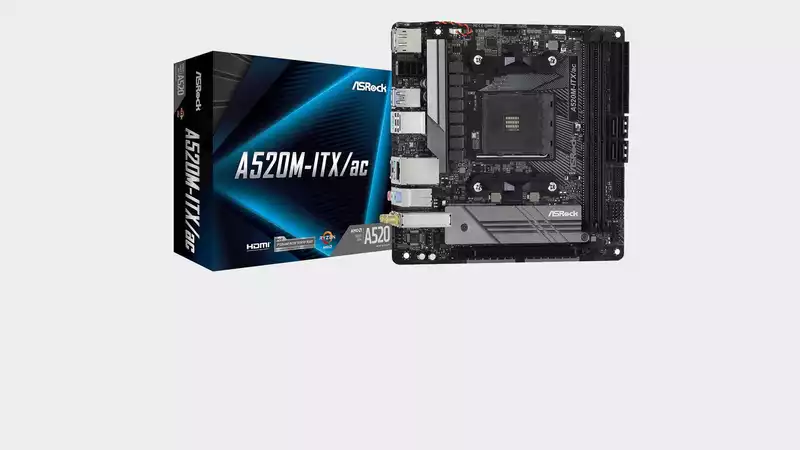AMD's budget Ryzen motherboard chipset, the A520, has received little attention; the B350 and B450 motherboards were considered entry-level, while the A320 was resolutely low-end.
The introduction of the B550 motherboard and the accompanying price increase left a big hole in the sub-$100 market: the A520. If you have a limited budget and don't care about PCIe 4.0 or the overclocking support that the B550 offers, an A520 motherboard may be exactly what you need. However, a decent A520 motherboard can do almost everything a board twice its price can do.
You could get an Nvidia RTX 3080, a top spec NVMe SSD, and 32GB of DDR4-3600 and use them all on an A520 motherboard. It's an unlikely combination, but still a high-performance one.
Let's also compare the A520 and Intel's B460 motherboard a bit. Memory speeds can far exceed the B460's DDR4-2666 or 2933 hard limit, and thanks to the more power-conserving nature of Ryzen CPUs, you are less likely to encounter VRM heating issues.
In addition, there is support for the upcoming AMD Ryzen 5000 series and, just as importantly, the Ryzen 4000 series APUs; combining a Zen 3 CPU with a motherboard like this ASRock A520M ITX/ac will allow you to build an affordable, compact and compact system at an affordable price.
The ASRock A520M ITX/ac is one of the most expensive A520 boards at $105. In fact, it may be the most expensive in many markets. This is a bit unusual for ASRock, which is usually known for very competitive low-priced products. However, it is one of the few A520 boards with WiFi, which is very useful on its own; while the Wifi 6 is not the Usain Bolt of WiFi speeds in general, it is adequate for high-speed Internet.
The A520M ITX/ac has an 8-phase DRMOS VRM with 60A choke. Spec-wise, it is surprisingly good for an A520 board. The only concern is the very small heatsink. I wouldn't try to overclock a Ryzen 9 3950X with liquid nitrogen on this board, but with a smart combination of a 65W CPU and a PBO, it should be fine as long as the case has airflow.
Being an ITX board, there are only two RAM slots, but this is not a problem as it supports up to 64GB; not a single user is going to install more than 64GB of RAM on a $100 board. What matters is the speeds supported; there are none of the ridiculous limitations of 2,666 MHz B460 memory. You can run up to DDR4-4600 if you really need to, but with today's Ryzen 3000 CPUs it is better to keep it at 3600MHz. However, it is rumored that this situation will change once Zen 3 CPUs start loving DDR4-4000.
The M.2 heatsink is solid and sturdy, and well positioned to allow airflow towards the rear case fans. There are four SATA ports, standard on ITX boards where space is limited. Also worth noting is the inclusion of RGB and ARGB headers; let's fool our friends into thinking the $105 board is worth more.
Rear I/O is very standard, with six USB ports, consisting of two 2.0 ports and four 3.1 Gen 1 ports. While one would like eight USB ports on all but very inexpensive boards, ASRock's little board is almost unique; the presence of both HDMI 2.1 and Display Port 1.4 means that proper 4K/60Hz is possible with the Renoir APU.
Realtek RTL8111H LAN and ALC887 audio are also available; the ALC887 chip is over a decade old and a bit underwhelming compared to the ALC1200 found in the Gigabyte A520 Aorus Elite. If proper HiFi is high on your list of priorities, there are better ones out there.
As we often say, the performance of modern motherboards is usually well within the standard margin of error. When outliers are seen, it is often due to aggressive multi-core turbo modes or ambient temperatures that affect the GPU boost clock. ASRock performed as expected; storage performance with the Samsung 970 Pro was strong; and the GPU boost clock was very good.
Gaming differences were minimal, as expected, whether pairing the A520 ITX with a high-quality GPU, pushing a high refresh rate monitor, or playing eye candy games at 4K.
Just the inclusion of WiFi makes this little ASRock one of the few attractive purely affordable ITX options, and when paired with a Ryzen 3300X or similar, you can reallocate your budget to a better graphics card or a large SSD. Also, compatibility with the upcoming Ryzen 5000 series CPUs is great; if you believe AMD, the 65W 5600X seems like a pretty great upgrade.
Just don't forget to update your BIOS before installing it.
A 105W CPU won't blow you away, and if you don't mind 7,000MB/s PCIe 4.0 SSD transfers, you can do almost everything a board twice the price can do.
Audio on the ASRock A520M is a bit disappointing, but this is something that budget boards often compromise on. Gamers listening to compressed audio assets in-game will likely not lose immersion.
The smaller ASRock A520M ITX/ac has the important bits and pieces and works well as the core of a budget gaming system. It benefits from the advantages of the Ryzen platform and is future-proof. ITX fans looking for an affordable AMD Ryzen should definitely add this product to their list of candidates.
.

Comments